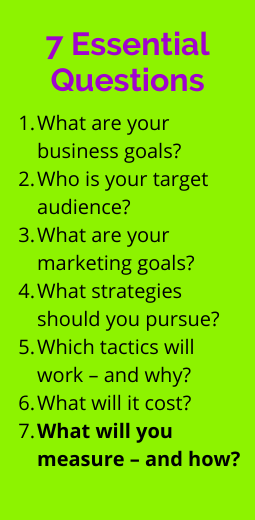|
It’s planning season for many businesses. That’s why over seven weeks we’re posing seven questions you should ask yourself and your team that will inform your marketing planning for 2020. This week we explore our seventh and final essential question: "What will you measure – and how?" Our recent posts covered setting business goals, defining audience, marketing goal-setting, strategy development, choosing tactics and determining a budget.  As a blog from email marketing firm Litmus recently put it, “Imagine you logged into your bank account and noticed that your balance had mysteriously increased by $1,000. You had no idea where that money came from or why it was there. It just... happened. “The next morning, you logged in again. This time, your balance went down $500. The next day, it went back up $1,000. And the following day, it dropped all the way to zero—again, with no clues or insight into why that happened. No cause. No culprit. All you knew was that it happened. “Now, here's a dumb question: How would you react to those swings? Unless you're the most relaxed person in the world, you'd freak. Not just about being broke, but because you had no idea how or why it happened.” We couldn’t have described it better. If you’re like most people, your reaction would be a mix of shock, panic, fear and disappointment. That's a trap you don't want to fall into. If you go to the trouble to build a strategic marketing program to build your business, you need to be able to track your progress – first to see if you need any course corrections, and second, to see if you’re getting a return on your investment of time and money. What's important to measure?What’s reaching people? Who’s reacting favourably or negatively? Is your audience growing – and are they converting to paying customers? Are they feeling a sense of excitement or loyalty toward you? You can group these types of questions into two guiding categories for measurement: quantitative and qualitative:
So how do you measure? There’s no perfect scenario or method, although you’ll find hundreds of articles out there describing each author’s “must do” top measurement priorities and techniques. They key is to develop your own, relevant system of metrics – the things you can count or be guided by – that work for your specific business. For example, a food business may track how many people redeemed the coupons they offered at a tasting event, while an accounting firm may track email marketing to see how many people made inquiries about help for tax season. An online shoe shop might survey their customers about their favorite colors or styles and track website traffic to see who’s browsing and for what. The best place to start is with your own customer’s journey. Try this exercise: take a sheet of paper and draw a long line on it. On that line mark and label points representing every possible interaction you’ve had with your customer, from when the first hear about you to when they buy your product or service and even afterward. You can get creative and branch out multiple lines to represent different customers or multiple ways the same customer interacts with you. Each of these points represents a marketing opportunity that can be measured. For example, if you’re running an ad online you can put in a custom coupon code that only people clicking on that ad will use. Use Google Analytics to track your web traffic to see how people use your site. Monitor who opens your email promotions and when – and which headlines seem to be attracting the most attention. Run a survey of your café customers to ask their favorite winter dishes or flavors, or ask them questions about satisfaction and customer service. Feeling overwhelmed? Don’t worry, you’re not alone. Brands big and small struggle with understanding whether their marketing is having an impact. Litmus studied email marketing alone and, as reported in their 2019 State of Email Analytics, nearly a quarter of brands can't track email interactions down to conversions. Fewer than half can measure their email marketing return on investment. And less than 28% of brands can measure subscriber lifetime value, which many consider to be the king of North Star metrics. So if the big boys have trouble, what’s a small business supposed to do? Just remember that putting a system in place that can help you be more strategic is better than no system at all. Track what you can and be open to learning from the information you gather. As in our opening analogy, you don’t want to the one at the bank wondering “where did all that money go?” Next week Our holiday round-up of fun examples and ideas to inspire your 2020. Last week What will it all cost? Making smart budget choices for your marketing efforts.
Comments are closed.
|
Author
I'm Tim Hart, owner, coach and trainer at LoveSmallBiz.com. I'm also owner of marketing communications firm Hart Communications. Archives
April 2020
Categories
All
|
Copyright Hart Communications. All rights reserved.



 RSS Feed
RSS Feed